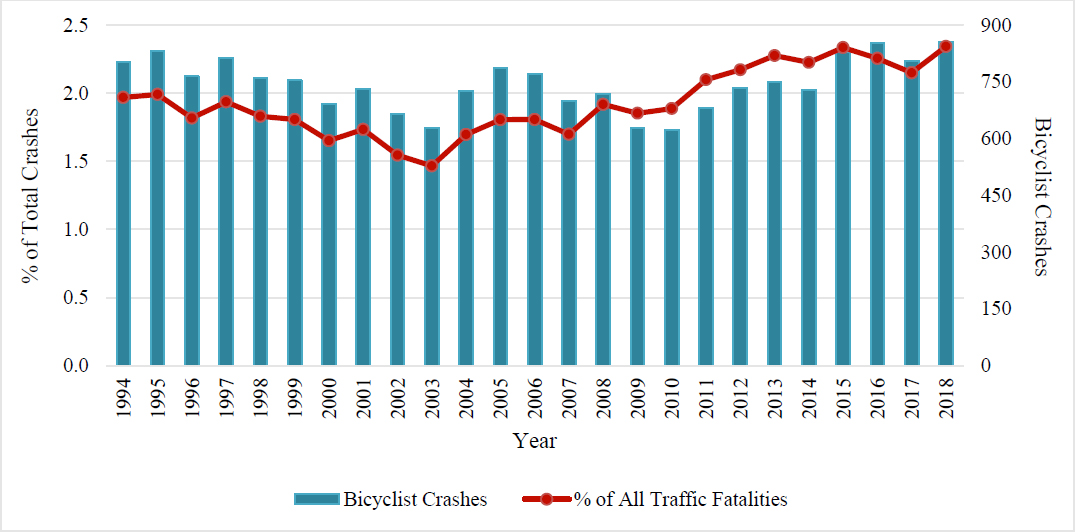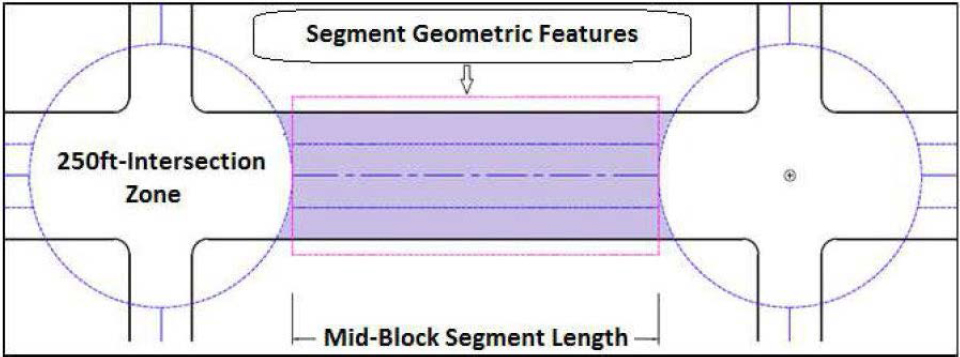Safety Evaluation of On-Street Bicycle Facility Design Features (2025)
Chapter: 1 Introduction
CHAPTER 1. INTRODUCTION
1.1 BACKGROUND
Bicycling is an ideal mode of transport for short- and medium-distance trips that has many health and environmental benefits (Pucher and Buehler, 2008). However, bicycling was not considered a mainstream mode of transport and was excluded from travel and transport surveys until recent decades (Pucher and Buehler, 2017).
Through the 1970s and 1980s, traffic engineers and the vehicular cycling (VC) community vocally opposed separating bicyclists from traffic. VC theory held that bicyclists were safest when they acted and were treated as the operators of vehicles; thus, bicyclists should be encouraged to operate in a shared space with motorists and no special accommodation was needed with the exception of the provision of wider travel lanes and smooth pavements (Pucher, 2001; Schultheiss et al., 2018). This perspective limited the installation of bikeways that separated bicyclists from motorized traffic in many communities across North America in part due to cautionary or restrictive language placed within guidance stemming from VC advocacy efforts or local opposition to bikeways. Through the 1980s and into the 1990s, the VC theory significantly influenced most of the engineering and planning efforts related to the accommodation of bicyclists on public roadways in the United States; this coincided with diminished federal support for guidance and related research (Schultheiss et al., 2018).
Support for bicycling facilities to accommodate bicyclists on public roadways only started gaining widespread attention in recent decades, partly due to the increasing number of bicyclist fatalities and subsequent concerns of bicycling advocacy groups. The number of bicyclist fatalities increased from 1.9 percent to 2.2 percent of total crashes from 2009 to 2018, despite making up less than 1 percent of trips in the United States and despite dramatic improvements in driver and passenger safety during the same period (Figure 1). Data from the Fatality Analysis Reporting System (FARS) and the General Estimates System (GES)/Crash Report Sampling System (CRSS) indicates that most of the crashes (59 percent) resulting in bicyclist fatality occur at non-intersection midblock locations, emphasizing the need for separating bicycles from oncoming traffic (Table 1).

Figure 1. Trends and Comparisons of Bicyclist Fatalities.
Table 1. Bicyclist Fatalities, Nonfatal Injuries, and Crashes by Crash Location in the United States (2016–2018).
| Locations | Based on FARS Data | Based on National Automotive Sampling System–GES/CRSS Data | ||||
|---|---|---|---|---|---|---|
| Fatalities | % | Estimated Nonfatal Injuries | % | Estimated Injury Only Bicycle-Motor Vehicle Crashes | % | |
| At Intersections | 715 | 28 | 47,648 | 30 | 105,333 | 66 |
| Non-intersection | 1,475 | 59 | 37,235 | 23 | 54,243 | 34 |
| Other/Unknown | 326 | 13 | 75,482 | 47 | ||
| Total | 2,516 | 100 | 160,365 | 100 | 159,576 | 100 |
Source: Adopted from FARS and GES/CRSS, NHTSA.
The increasing number of bicyclist fatalities, subsequent concerns of bicycling advocacy groups who increasingly rejected VC philosophies, and the publication of the National Association of City Transportation Officials’ (NACTO) Urban Bikeway Design Guide in 2010 led to a proliferation of bikeways that separate bicyclists from motorized traffic throughout North America over the last decade. To address these concerns, many state and local departments of transportation
(DOTs) have started installing bicycle-specific facilities or adjusting the existing roadway facilities to accommodate bicyclists at midblock locations. A midblock location is defined by the National Transportation Safety Board (NTSB) as “any point along a roadway between intersections (excluding approach areas leading into or out of an intersection)” and is expected to include all road characteristics, including driveways and minor low-volume public intersections (presented as a density value), median treatments, and similar longitudinal features (NTSB, 2019). Figure 2 depicts an example of a midblock location. As observed, a 250 ft buffer zone is usually applied to distinguish the intersection zone and related crashes from the midblock location (Mbatta, 2011).

Each bikeway type installed at midblock locations is associated with certain benefits and challenges that impact its effectiveness and suitability. For example, a separated bike lane (also referred to as a protected bike lane or separated bicycle lane) provides lateral separation between motor vehicles and bicycles while also introducing a vertical element to provide physical separation. While this treatment meets most bicyclists’ comfort needs, it also requires a wider paved surface, potentially more costly right-of-way, and a transition to a less restrictive configuration at intersection locations to permit smooth traffic operations (common types of on-street bikeway types installed at midblock locations and along segments are discussed in the Guidance Report).
1.2 GAPS AND LIMITATIONS
There is a growing interest among state DOTs and other transportation agencies in deploying more bicycle facilities with an apparent trend toward separated and other innovative on-street bicycle facilities. Despite this guidance and interest, there is a lack of information regarding the
safety benefits associated with the various on-street bicycle facility designs installed at midblock locations. In North America, state DOTs and other transportation agencies are implementing more robust data-driven quantitative safety approaches and predictive methods developed in American Association of State Highway Transportation Official’s (AASHTO) Highway Safety Manual (HSM). This document, published in 2010, recommends using historical crash-based, predictive methods to assess and evaluate the effectiveness of a safety improvement (AASHTO, 2010). Bicycle-related research targeted for the second edition of the HSM has been completed recently (NCHRP 17-84: Pedestrian and Bicycle Safety Performance Functions for the Highway Safety Manual). Though this effort did not comprehensively capture the safety effects of all bicycle facilities, it has clarified that current data limitations need to be addressed as a critical step toward quantifying safety performance at these facilities. Some of the data limitations found in the bicyclist safety literature include but is not limited to sample size of existing treatments, exposure data and lack of crash data. Many agencies do not keep the record of bikeway treatments installed on roadway network, while the agencies keeping track of these records do not use consistent terminology to define the bikeway type. For example, separated bicycle lane can be referred to as major separation, cycle track and protected bike lane, which might make the data collection process challenging. Another major limitation is the lack of bicyclist exposure data that is currently available for only a select number of locations. Motor vehicle and bicycle exposure information are both critical inputs into an effective safety assessment effort. The third challenge is the quality of the crash report location as it relates to a bicycle-involved crash. Some transportation agencies record the crash location in a manner similar to their method for reporting motor vehicle crashes (as often a motor vehicle is one of the parties involved in the bicycle crash). Other jurisdictions will record the bicycle crash location as occurring at the closest intersection. A third reporting approach is to record the crash to either the closest intersection or the midblock point (whichever is the nearest to the actual crash location). Consequently, crashes involving bicycles are often only reported if there is damage to a vehicle, or if a bicyclist is severely or fatally injured, and sometimes the exact location of the crash is not recorded, which may present challenges for conducting the HSM-based predictive analysis. In a study of long-term trends of bicycle fatalities in the Netherlands, Schepers et al. (2017) found that bicycle fatalities may not be fully reported.
Lack of robust database can lead to inconclusive findings when estimating the safety effectiveness of bikeway facilities installed at midblock locations. For example, a critical review of literature on the safety impacts of bicycle infrastructure installed both at bicycle corridors and
intersections found that bikeways can affect bicyclist safety both positively and negatively (DiGiola, et al., 2017). This study also found that most previous studies did not account for bicyclist exposure, did not implement robust methods, and did not find significant estimated impacts which can be attributed to the lack of robust data. Additionally, bicycle-related crash modification factors (CMFs) included in the Federal Highway Administration’s (FHWA’s) CMF have very low star rating indicating that installing these treatments will not necessarily result in crash reduction. This lack of evidence when assessing the safety effectiveness of on-street bikeways can lead to limited design guidance. In particular selection of sites and design characteristics for improving bicyclist safety on a roadway network can become challenging if these decisions are supported by evidence-based solutions.
1.3 RESEARCH GOAL
The objective of the NCHRP Project 15-74 is to develop data-driven guidelines for selecting context-appropriate design features for safety improvements of on-street bikeway designs, including separated and non-separated on-street bicycle facilities. The guidelines will also provide transportation professionals with safety-based information for the planning of new facilities that can be used by practitioners at state DOTs and other transportation agencies. The methods used in this research include quantitative data-driven safety techniques, contextual application, land use pattern assessments, and design guidance using bicycle-involved crashes that occur at midblock locations.
1.4 REPORT ORGANIZATION
This report presents the literature review, roadmap for identifying the contextual factors affecting bicyclist safety, data assessment and collection, site selection and safety analysis. Chapter 2 of this report summarizes the conducted literature review and state-of-the-practice review related to bicyclist safety. Chapter 3 presents the identification and selection of contextual factors for evaluating the safety effectiveness of bikeway types considered in this study. Chapter 4 provides a data assessment and collection plan. Chapter 5 provides an overview of selected sites and data summary per sites, while Chapters 6 reports the results of the conducted safety analysis. Finally, Chapter 7 provides concluding remarks and recommendations for additional research.




